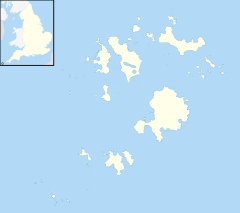Porth Hellick facts for kids
Quick facts for kids Porth Hellick |
|
|---|---|
 A snipe at Porth Hellick Pool |
|
| OS grid reference | SV925105 |
| Unitary authority | |
| Ceremonial county | |
| Region | |
| Country | England |
| Sovereign state | United Kingdom |
| Post town | ISLES OF SCILLY |
| Postcode district | TR21 |
| Dialling code | 01720 |
| Police | Devon and Cornwall |
| Fire | Isles of Scilly |
| Ambulance | South Western |
| EU Parliament | South West England |
| UK Parliament |
|
Porth Hellick is a special bay on the south coast of St Mary’s. This is the largest island in the beautiful Isles of Scilly. Porth Hellick is a "tidal inlet," which means the sea flows in and out with the tides.
The bay has a cool natural border. To the south, there's a rocky point called the Giant’s Castle. This was once an Iron Age cliff fort, a type of ancient fort built on a high cliff. To the north are Porth Hellick Down and Porth Hellick Point.
When the tide is low, you can see a wide area of sand and rocks. A natural wall of small stones, called a shingle bar, keeps the sea out. This forms the biggest area of fresh water on St Mary’s. A small stream starts in Holy Vale and flows into this fresh water pool. This stream helps keep the pool full.
Porth Hellick is super important for birds. Many birds stop here when they are migrating (traveling long distances). It's also a great place for birds to spend the winter. Because of its amazing nature, this area was named a Higher Moors and Porth Hellick Pool (St Mary's) Site of Special Scientific Interest (SSSI) in 1971. This means it's a protected area with many different habitats and rare plants.
Exploring Porth Hellick's Nature
Porth Hellick is one of three main freshwater wetland areas in the Isles of Scilly. A wetland is a place where the land is covered by water, like a marsh or swamp. This wetland gets its water from underground and a small stream.
Plants and Trees of the Wetland
The area is a mix of different types of plant life. You can find willow and alder trees growing here. There are also wet, boggy areas called mires, and several pools of water.
The ground has deep layers of peat. Peat is made from old, decayed plants. Long ago, people used to dig up this peat for fuel. These peat layers are like a time capsule! They hold tiny bits of pollen from ancient plants. Scientists study this pollen to learn about what the islands looked like thousands of years ago.
Birds and Wildlife
Porth Hellick is a busy spot for birds. It's a vital feeding ground for birds that are migrating or spending the winter. In the summer, you can also see many different waterfowl here.
Along the edges of the pools, you'll find tall common reeds. Birds like the Reed Warbler and Sedge Warbler build their nests in these reeds. Other birds that breed here include Coot, Gadwall, Mallard, Moorhen, Teal, and Water Rail.
The moors, which are open, wet grasslands, were once used for grazing animals. Now, they are home to many interesting wet grassland plants. Look for Greater Tussock-sedge, Hemlock Water-dropwort, Purple Loosestrife, Royal Fern, Water Mint, and Yellow Iris. In the very wet, boggy spots, you might spot Bog Pimpernel, Bog Stitchwort, and Marsh St John’s-wort. In the wettest areas, Lesser Spearwort grows.


